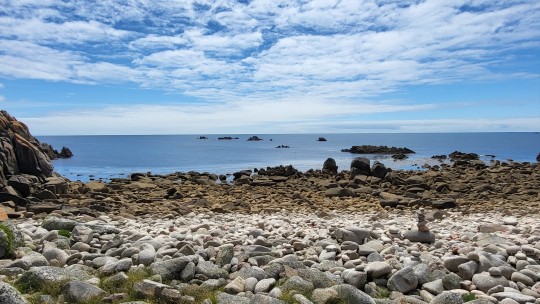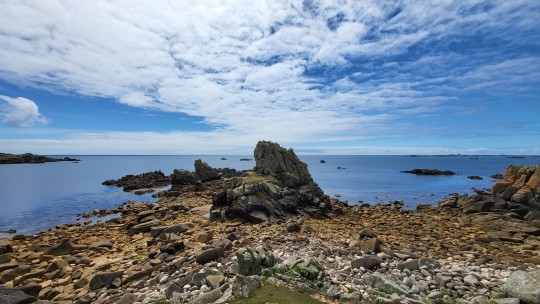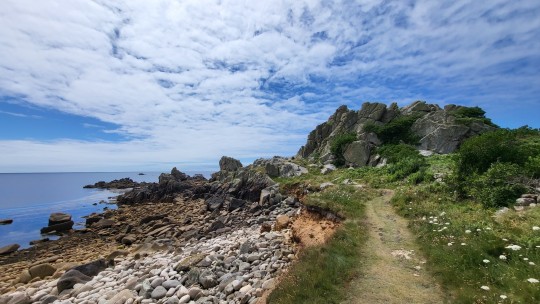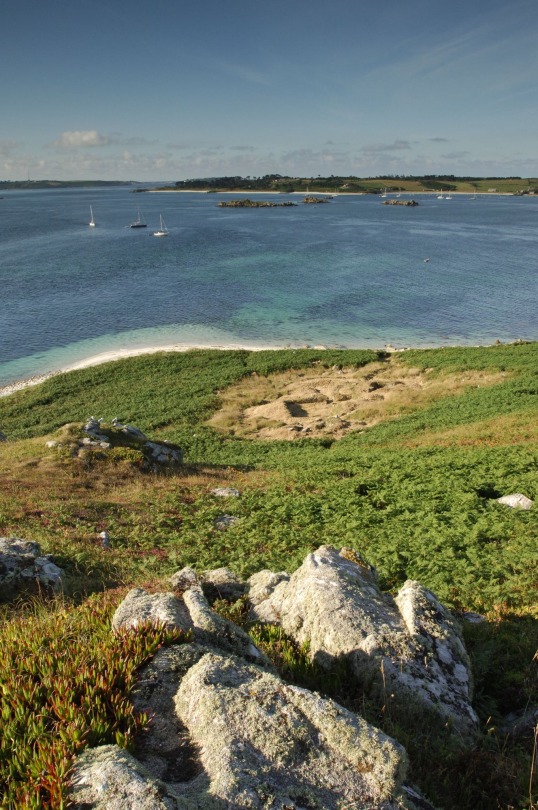#isles of scilly
Text
Women’s history just got richer
Iron Age remains found on the Isles of Scilly belonged to a female warrior, according to the authors of a new study that challenges long-held assumptions about the historical role of women in warfare.
Ever since the burial site was discovered in 1999 at a farm on the British island of Bryher, scientists have been at odds as to whether it belonged to a man or a woman. But thanks to a modern technique that involves analyzing the proteins found in tooth enamel, archeologists say they finally have an answer.
"We found that this 2,000-year-old burial — one of the richest burials in the southwest of Britain — was a female, or a woman," human skeletal biologist Sarah Stark told As It Happens guest host Aarti Pole.
"It really is opening the door to this hidden female warrior."
Stark works for Historic England, a public agency dedicated to the preservation of historical sites, which led the study into the Iron Age remains. The findings were published in the Journal of Archaeological Science: Reports.
The sword and the mirror
Iron Age graves with swords usually belong to men, while those with mirrors tend to belong to women, says Stark. But the Bryher burial site contains both.
"This is something that really sets the Bryher burial apart," Stark said. "This kind of tipped us off into knowing that this person — this woman — was of significance."
She and her colleagues suspect she was "someone that was organizing, commanding or leading in warfare at this time."
Stark says there's a lot we don't know about Iron Age Britain before the arrival of Romans — but one thing we know for sure is that violence and warfare was common.
"We see that men and women were engaging in kind of violent activities based on the trauma that we've seen in other bones in surrounding areas," she said. "So it's not out of the ordinary to think that both men and women should be able to defend themselves."

This presence of both a sword and a mirror in the grave confounded researchers for the last two decades. (Historic England Archive)
It's not just the sword that's connected to war, she says, but potentially the mirror too.
"To be able to signal to others through beams of light would be a huge advantage, both in either warning … others your in party of a potential attack, or co-ordinating an attack," she said.
Archeologist Bettina Arnold, who was not involved with the study, cautioned against assuming the presence of a sword means the person was a warrior.
Arnold, a University of Wisconsin Milwaukee professor who studies the Iron Age, says it's not uncommon to find weapons buried with women or various types of leaders. They symbolize that "you are protecting your community," she said.
"It's probably more likely a symbol of authority, and of a particular kind of leadership role," Arnold said. "That doesn't necessarily mean they were actually riding into battle."

These Iron Age human remains from Bryher were too fragmented and deteriorated to obtain DNA. (Historic England Archive)
Mirrors, she said, have also been associated with religious or spiritual roles, including fortune telling.
Arnold says she doesn't doubt the existence of female warriors in history, and that, in fact, men may have also been wrongly assumed to be soldiers because of the weapons found in their graves.
To be certain about any individual case, she says you would require multiple lines of evidence, such as markings on the remains that indicate an individual had been in combat.
Tooth technique a real 'game changer'
The human remains found at Bryher, however, are badly fragmented and poorly preserved. That's why previous attempts to determine sex using DNA failed.
But this time, the researchers turned to the teeth.
"Tooth enamel is the hardest and most durable substance in the human body. It contains a protein with links to either the X or Y chromosome, which means it can be used to determine sex," co-author Glendon Parker, a toxicology at the University of California at Davis, said in a press release.
Analysis of the Bryher remains show a 96 per cent likelihood the bones belonged to a female.
"Given the degraded state of the bones, it's remarkable to get such a strong result. It makes you wonder what could be discovered by re-visiting other badly degraded burials," Parker said.

Aerial view of Bryher island, part of an archipelago known as the Scilly Islands in the United Kingdom. (Dan Turdean/Shutterstock)
The same technique was recently used to reclassify 5,000-year-old remains from an ornate Spanish tomb from male to female.
Arnold called the tooth enamel technique "a total game changer" that's more cost-effective than DNA testing, and more accurate than interpreting objects found in graves.
Stark says it "opens a huge realm of possibilities where we might start, again, uncovering ... more hidden female warriors."
"We might find it's actually quite common," she said. "We've just been kind of missing them."
Changing historical narratives about gender
This study comes as scientists are re-evaluating many long-held assumptions about gender roles throughout history.
In one recent study, published in June, researchers dispel what they call the "myth" that men were primarily hunters and women were gatherers in early human populations.
And in 2017, advanced DNA analysis was used to identify a Viking warrior's remains as female.
In the latter case, some archeologists argued those remains could have belonged to someone who, in today's parlance, would be considered transgender or non-binary.
"That's part of the problem, too, that we're projecting our own ideas — you know, the sort of binary system that we're still kind of tied to, unfortunately — projecting that into the past. And I think you miss a lot that way," Arnold said.
Stark agreed it's something worth considering.
"It's something we want to be quite mindful of when we sort of start to think … in terms of gender and identity, and taking kind of our modern constructs and applying them to the past," she said.
18 notes
·
View notes
Text








Geology rocks, St Agnes, Isles of Scilly, Cornwall /Kernow
66 notes
·
View notes
Photo

Via @PastPostcard
6 notes
·
View notes
Text

30/9/2022. Seascape, monochrome, acrylics. Scilly Isles. Work in progress.
7 notes
·
View notes
Text
The long peaceful war.
The ‘Three Hundred and Thirty Five Years’ War lasted from 30 March 1651 to 17 April 1986.
The “war” between the Netherlands and the Isles of Scilly is one of those curious historical footnotes that often draws a few chuckles. This conflict, if it can even be called that, occurred in 1651 during the First Anglo-Dutch War. The Isles of Scilly, a small archipelago off the southwestern tip of…

View On WordPress
0 notes
Text
8th August
St Lide’s Day

Source: coolplaces.co.uk
Today is St Lide’s Day. Lide was an eleventh century hermit who lived on the Isles of Scilly and gave an expanded and cross-gender version of his name to the island known as St Helen’s. This rather strange transformation probably arose from the fact that Lide itself is likely to have been an abbreviation of the saint’s full name, Elidius - which is still a stretch but not as great a one as the Elid/Helen original. St Helen’s Chapel was a place of pilgrimage in the Middle Ages and pirates were warned off attacking the island by Lide’s threat of instant excommunication. The Scilly Isles are also said to be the remnants of the mountains of Lyonesse, the mythical realm once ruled by King Arthur and long since sunk under the waves of the English Channel.
Apparently A rainy August/ Makes hard bread crust, whereas Dry August and warm/ Doth harvest no harm. Also a thunderstorm in early August means they will be commonplace for the rest of the month.
0 notes
Text
The Brutal Tide by Kate Rhodes
Today I am sharing my thoughts on the 6th Ben Kitto novel from Kate Rhodes, The Brutal Tide.
@K_RhodesWriter
@simonschusterUK
#books #booktwitter #booktwt
Today I am delighted to share my thoughts on the latest novel from Kate Rhodes, The Brutal Tide, book six in the Ben Kitto series. I’ve really enjoyed this Scilly set series and was so excited to be granted an early copy of the book courtesy of publishers Simon and Schuster. Here’s what it’s all about:
Source: NetgalleyRelease Date: 27 October 2022Publisher: Simon & Schuster
(more…)

View On WordPress
0 notes
Text
youtube
#cornish pottery#ceramic art#handmade ceramics#video post#isles of scilly#humfrey wakefield#ceramicists#exhibition's#Youtube
1 note
·
View note
Text

Island Pride, St Agnes, Isles of Scilly, Cornwall /Kernow
47 notes
·
View notes
Photo

FALL IN LOVE WITH BRITAIN’S BRIDGES, BUSES, BLUE SKIES, BEACHES.
Read More @ https://www.7seasholidays.co.uk/places-to-visit-in-united-kingdom/
0 notes
Text

The Old Rectory, St Agnes, Isles of Scilly
0 notes
Text

A photograph by Francis J. Mortimer, a British photographer from the late 19th to early 20th centuries.
This is the wreck or the Arden Craig off the Scilly Isles, England in 1911 and Mortimer is approaching in a rescue boat.
Though known for his pictorial style this one crosses genres into early photojournalism while maintaining the mystique and romanticism of life on the seas.
#Francis J. Mortimer#photographer#British#Arden Craig#ship#shipwreck#Scilly Isles#England#1911#rescue boat#photojournalism#the sea#vintage photography#St Agnes Isles of Scilly#Francis James Mortimer
3 notes
·
View notes
